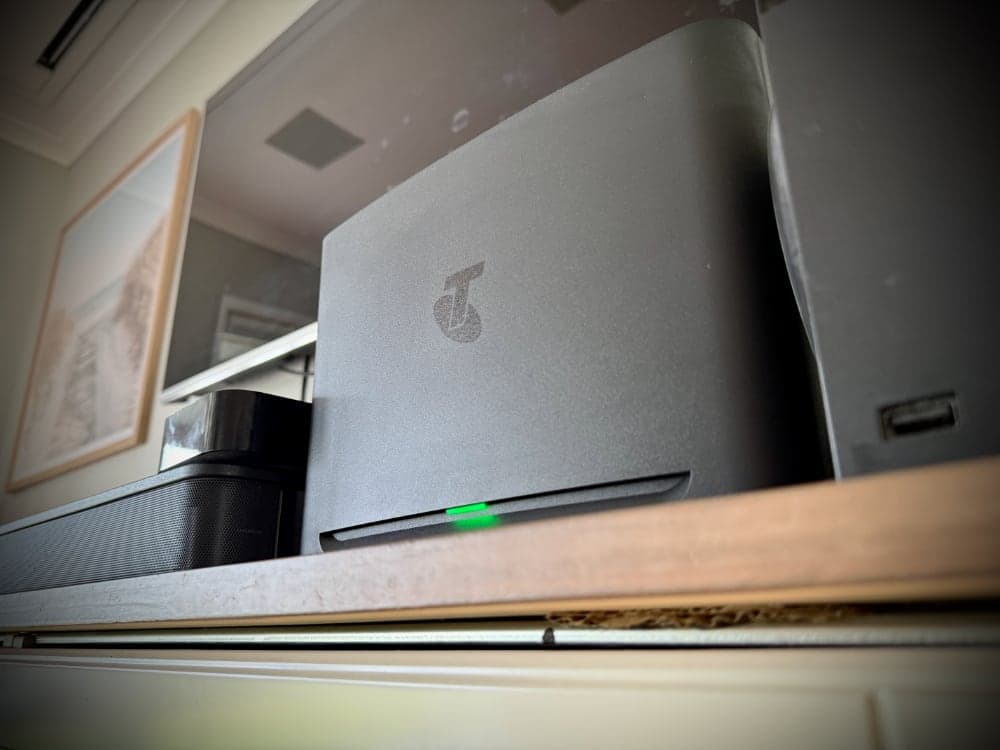- Published on
Telstra Smart Modem 4: A Comprehensive Review
- Authors

- Name
- Edwin Popham
The Telstra Smart Modem 4 has been making waves in the Australian telecommunications market. As Telstra's latest flagship modem, it promises enhanced performance, better coverage, and smarter features. But does it deliver on these promises?

What's New in the Smart Modem 4?
Telstra's most advanced modem yet brings significant upgrades:
- Wi-Fi 7 Technology: Next-generation 802.11be dual-band router for Wi-Fi 7 devices
- Massive Device Support: Connect up to 256 devices simultaneously
- Enhanced Performance: 2GB RAM (double the previous modem) handles more devices without slowdown
- Intelligent Wi-Fi: Automatically sends the best frequency to each device
- Better Coverage: Greater range than previous modems with R6 EasyMesh support
- Enhanced Security: WPA3 security protocol
While it is only a dual-band Wi-Fi 7 modem, which is a slight limitation compared to tri-band options, the Smart Modem 4 is still competitively priced at just over $200. For cutting-edge technology at this price point, it’s solid value.
Upgrading from the Telstra Smart Modem 2
Coming from the Telstra Smart Modem 2, the upgrade to Smart Modem 4 has been a noticeable step up. I deliberately chose to stick with the Smart Modem series even though I'm no longer a Telstra customer. This was a strategic move: given Telstra's dominant market share, the Smart Modem line is likely the most widely used modem range in Australia, so it benefits from extensive support and community knowledge online.
Having the latest Smart Modem means access to the newest features like Wi-Fi 7 and smarter device management, while still relying on a platform with plenty of resources for troubleshooting and optimisation. For anyone considering their next modem, this continuity and ecosystem support can be just as important as raw performance.
Real-World Testing: High-Demand Network
My home network presents some unique challenges that really put the Smart Modem 4 to the test:
Network Setup
- 8 adults using internet simultaneously
- 40+ connected devices including smart home devices, laptops, phones, tablets
- FTTN connection using VDSL with Aussie Broadband
- External Wi-Fi extender serving a separate building on the property
- Ethernet-connected access point in the garage
- Mixed usage patterns from streaming and video calls to IoT devices
Performance Results
Device Capacity: The Smart Modem 4's ability to handle 256 devices is genuinely useful here. With 40+ devices connected, there's no noticeable slowdown compared to our previous setup.
Multi-Building Coverage: The improved range and R6 EasyMesh support work well with our external extender setup. The intelligent band steering helps manage device connections across the extended network.
Concurrent Usage: With 8 adults simultaneously streaming, video calling, and browsing, the 2GB RAM and Wi-Fi 7 technology maintain stable performance. The automatic channel selection helps avoid congestion.
VDSL Compatibility: Works seamlessly with FTTN connections via VDSL. The built-in VDSL modem handles the connection reliably, and the Wi-Fi 7 capabilities aren't bottlenecked by the FTTN speeds.
Ethernet Backbone: The 4x Gigabit LAN ports provide solid wired connections for our garage access point and other high-bandwidth devices.
Device Compatibility Challenges
One major drawback I’ve encountered is with device compatibility. Specifically, one of my Wi-Fi strip lights and my Ring doorbell experienced connection issues on the Smart Modem 4. I experimented by turning off band steering and reverting to Wi-Fi 6 mode, but the connection problems persisted.
For me, it wasn’t worth sacrificing the full benefits of Wi-Fi 7, so I switched back to band steering and Wi-Fi 7 mode. When band steering is off, this modem essentially cannot utilise Wi-Fi 7 features, limiting its performance and smart connectivity benefits.
Setup and Configuration
Setting up the Smart Modem 4 is straightforward:
- Connect the modem to your NBN connection point
- Power on and wait for the status lights to stabilise
- Connect your devices using the default Wi-Fi credentials
- Access the admin panel at
192.168.0.1for advanced configuration
Pros and Cons
Pros
- Handles 40+ devices without performance degradation
- Wi-Fi 7 provides excellent throughput for high-demand scenarios
- 2GB RAM prevents slowdowns during peak usage
- Works seamlessly with existing network extenders and access points
- Intelligent band steering optimises multi-device performance
- Reliable 4G backup for business continuity
Cons
- Limited customisation options for advanced network configurations
- No advanced QoS controls for prioritising specific devices/applications
- Some device compatibility issues with Wi-Fi 7 and band steering settings
Conclusion
For high-demand networks like mine with multiple buildings, numerous devices, and heavy concurrent usage, the Telstra Smart Modem 4 delivers solid performance. The Wi-Fi 7 technology and increased RAM make a noticeable difference when managing 40+ devices and 8 simultaneous users.
While it lacks the advanced configuration options that network enthusiasts might want, it excels at handling complex scenarios without requiring technical expertise. The automatic optimisation features work well in practice, even if you can't fine-tune them manually.
Best for: Telstra customers with high device counts, multiple users, or extended network setups who want reliable performance without complex configuration.
Consider alternatives if: You need advanced QoS controls, want to use non-Telstra internet, or require extensive customisation options.
Have you used the Telstra Smart Modem 4? Share your experience in the comments below.